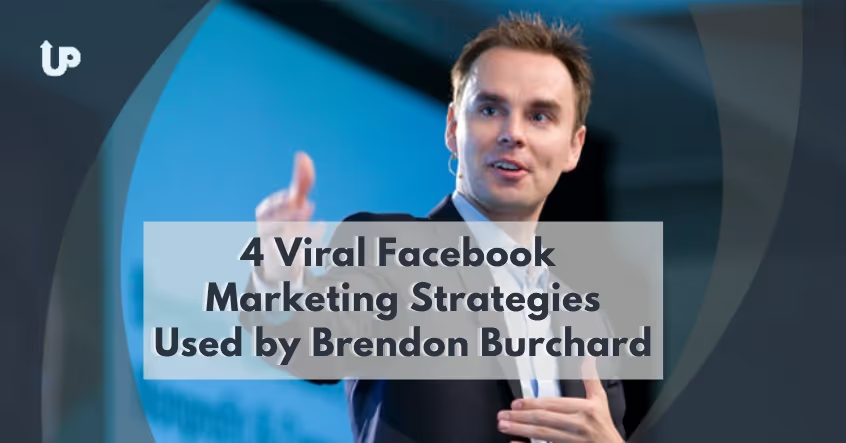Brendon Burchard is one of the top motivation and marketing trainers in the world and was one of the 25 most influential leaders in personal growth and achievement. Quite a feat!
This didn’t happen overnight and for no reason.
Brendon worked his ass off to get here. And because of that, he’s learned some great insights along the way. From meeting celebrities like Oprah and Larry King, Brendon Burchard has left a mark on the world of digital marketing and this article is all about taking his findings and distilling them down to a quick read.

If you’re a small business owner looking to grow, these days Facebook is the obvious choice.
Why?
Not only have you seen other ad campaigns take hold and take off on Facebook, but also because it has more than 1 billion users worldwide.
In this article we’re going to go from beginning to end, through all the steps in launching a viral Facebook marketing campaign by Brendon Burchard, highlighting 4 key steps - from getting noticed to converting that attention into email subscribers, ready and waiting for your next big message, and how you can set yourself up for success with an effective email automation strategy.
Remember: Going viral is great. Knowing what to do with that burst of traffic is better.
So - Let's get started!
Step 1: Become a puffer fish
You’ve seen them before, right? Also called fugu, and if prepared incorrectly can kill you.

Well, the Facebook page for your business has some similarities to the cuddly little fugu. As a small business owner you may feel small, but with the right positioning, you can make yourself appear to be a much larger brand than you actually are.
Now, if you’re just getting started, the first step to a viral marketing campaign is getting a Facebook page up and running. There is some debate about whether it’s better to have a Facebook page or a blog page, and being completely blunt, start with a Facebook.
Not only does Facebook have over a billion users ready for you to advertise to, but unless Wordpress and HTML are your cup of tea, odds are, it's going to be MUCH easier to get your brand up and running on Facebook.
To continue our transformation into a larger fish, you’ll need to start publishing content. This could be blog posts, tweets, Instagram ads, anything, but should be interesting and educational.
Usually, a blog post every week or so is a good start, but if you can’t get any original content up, just share what others are posting and link back to them. This only requires you write a sentence or two about the post, and paste a link. It doesn’t matter how busy you are, anyone can, and should be doing this to build their reputation online.
The last step in the transformation is to re-link content to your own blog or site.
Hopefully, you have enough know-how on how to build a simple Wix or Squarespace website which you can publish your content on. Once it’s ready, you can do something we all learned in elementary school - recycle, reduce, reuse!
It’s ok to repost old content that you previously posted on Facebook on your blog.
Bonus tip - this also works the other way around. You can take people from your website to your facebook page using handy plugins like the “Like Box with the Activity Feed”.
The example below is from Tim Ferriss’ page, and easy to implement into your own blog.

Step 2: To quote the famous…
One of the easiest ways to create new content for your Facebook page is to use quotes. I KNOW you’ve seen them before. Was it Michael Jordan, the Dali Lama or good old Benjamin Franklin?

It’s a fact: people like quotes. They’re short and easy to read, but they can grant valuable insights, and there are plenty of great ones out there to choose from.
But how does quoting Ben Franklin help your business’ Facebook page?
It doesn’t.
But that isn’t to say that you can’t quote someone else who CAN help your business.
You know them. They work hard every day, know a lot about the industry, and have a modest following. Can you guess who they are yet?
It’s you!
You may not think you have anything special to say, but by using your own quotes, you can make some magic happen. Let’s take a look at a goofy quote by Brendon Burchard:

Pretty straightforward right? And look at the number of shares he got!
By using your own quotes you can advance your own brand, use your own messaging, and link back to your own content. This last part is key for running a quote campaign.
Ben Franklin isn’t talking about a real estate marketing service, and no matter how much you try to stretch his words, it won’t work. You, on the other hand, can make a quote relevant to your industry, and then link to your content.
To create a great quote post it must be visually appealing, have relevant content, and a link to your own page. Take a look at this example from Ryan Deiss:

It ticks off all the boxes, and is a great example.
Some other tips and tools you can use are bit.ly to shorten your links to your site, the Facebook grid tool to make sure your post (if it’s an ad) stays within the rules, and canva.com for making professional images in minutes, not hours.
Step 3: Make a connection
The key to any facebook marketing campaign is turning visitors into leads, by having them opt-in for something. This is the basics of any online funnel and is even easier to do on Facebook using handy tools like the FBML app. This lets you integrate opt-in forms directly into your ads to get leads signing up without leaving the site.
In this example, Brendon Burchard is using a video to get people to opt-in for his 8-week coaching program.

Breaking down Brendon’s ad, he’s using a few proven psychological tricks to get people to sign up and make a connection.
The first is a video with a picture of him. Our minds are hardwired to like seeing images of people, and he takes it one step further by having the still image look like he’s about to say something. This one-two punch increases his chances of getting a click.
He then goes out to give clear instructions “enter your first name and primary email” telling users exactly what he wants you to do. You might think this is overkill, but in the world of marketing you need to be a clear as possible with what you want users to do. You cannot assume that people will know you want their primary email. Stating that will help you get a better email address which visitors are more likely to check and open. He also capitalized and changed the color of free to red. Who doesn’t like something free? So make it as clear as possible.
The last trick he uses to increase conversions is putting a picture of his book. In reality you’re probably going to get a PDF file and not a thick meaty hard cover book, but by creating that imagery, your mind adds value to the PDF and makes it look like more than it actually is.
Step 4: Set it and forget it
Any real money made from a viral Facebook marketing campaign doesn’t come from the click of your ad, it comes from the follow up messages afterwards.
Being completely blunt, if you’re planning on manually sending the recommended 3-4 follow ups for all of your new leads you’re deluded.
It just isn’t going to happen. Consistently or reliably. You might be on vacation, out with friends, or sleeping. And the last thing you want to do at any of these times is hope on your computer and send an email.
To truly see success, you need to setup an autoresponder sequence. These days it’s pretty easy and cheap to set one up. You can use programs like MailChimp, Campaign Monitor or Infusionsoft to keep your business running while you sleep.
To quote Ron Poleil…

Much like his hyped up rotisserie oven sold in the late 90’s, once you setup an autoresponder sequence, you can go about your day and focus on the important things. This sequence will keep people interested in your messaging, and you’ll be able to automatically upsell them while you sleep.
For a basic autoresponder sequence used by industry leaders like Ryan Deiss and Brendon Burchard, they recommend using the following emails.
Day 0: You send the content the lead has opted in for.
Day 2: A light reminder if they didn’t download the content and a link to an up-sell. This up-sell could be a discounted product between $3 and $60, and its main goal is to turn a someone from a lead into a customer.
Day 4: Reminder about the up-sell, how much of a great value it is, and how they will benefit from it
Day 6: Introduce your main product, and tell them what an irresistible offer it is.
Day 10: Last chance reminder about the main product.
If writing 5 emails is out of the question, you should always at least find the time to draft and include the last chance reminder. People hate missing out on things, and these emails typically have a much higher conversion rate than the other.
By implementing all these strategies and following this process you’ll be well on your way to leveraging Facebook as a channel to grow your business.
Image Sources:
- www.brendon.com
- www.photonesta.com
- www.s3.amazonaws.com
- www.amyporterfield.com
- www.blog.txt2give.co





.png)